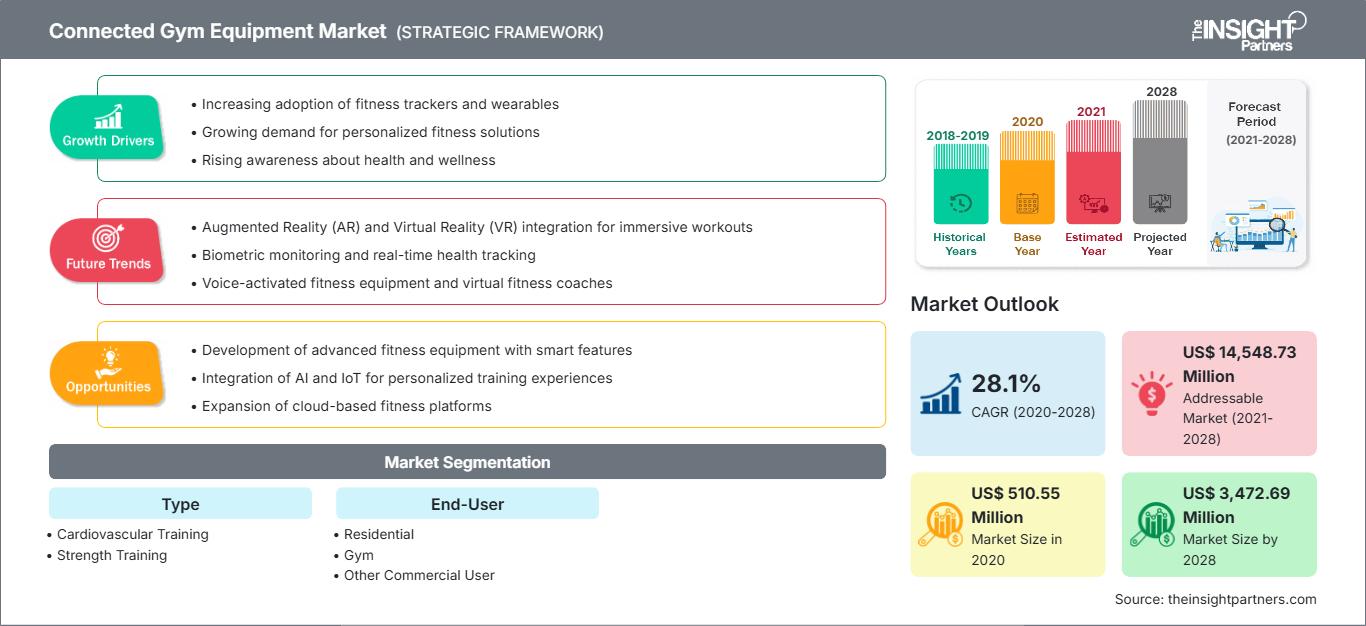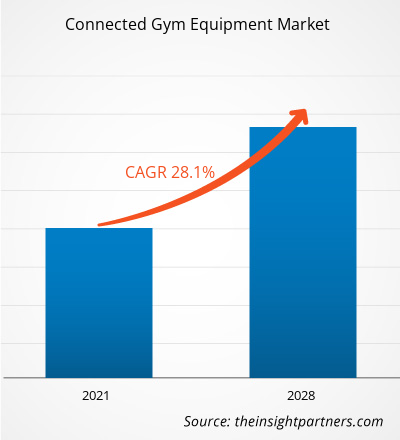Der Markt für vernetzte Fitnessgeräte wurde im Jahr 2020 auf 510,55 Millionen US-Dollar geschätzt und soll bis 2028 voraussichtlich 3.472,69 Millionen US-Dollar erreichen; von 2021 bis 2028 wird ein durchschnittliches jährliches Wachstum von 28,1 % erwartet.
Das steigende Fitness- und Gesundheitsbewusstsein steigert die Nachfrage nach vernetzten Fitnessgeräten. Vernetzte Fitnessgeräte erfreuen sich zunehmender Beliebtheit, da sie Daten sammeln und auf einem Server speichern, auf den von überall aus zugegriffen werden kann. Fitnessclubs setzen auf neueste Technologien, um neue Kunden zu gewinnen, was die Nachfrage nach vernetzten Fitnessgeräten steigert. Kleinere Fitnessstudios können ihre Systeme jedoch aufgrund der hohen Kosten nicht aufrüsten, was das Wachstum des Marktes für vernetzte Fitnessgeräte maßgeblich hemmt.
Passen Sie diesen Bericht Ihren Anforderungen an
Sie erhalten kostenlos Anpassungen an jedem Bericht, einschließlich Teilen dieses Berichts oder einer Analyse auf Länderebene, eines Excel-Datenpakets sowie tolle Angebote und Rabatte für Start-ups und Universitäten.
Markt für vernetzte Fitnessgeräte: Strategische Einblicke

-
Holen Sie sich die wichtigsten Markttrends aus diesem Bericht.Dieses KOSTENLOSE Beispiel umfasst Datenanalysen, die von Markttrends bis hin zu Schätzungen und Prognosen reichen.
Jüngsten Berichten zufolge gehören die USA, Indien, Brasilien, Frankreich, die Türkei, Russland, Großbritannien, Italien, Spanien und Deutschland zu den am stärksten von der COVID-19-Pandemie betroffenen Ländern. Die COVID-19-Pandemie hat den Industriesektor weltweit in Mitleidenschaft gezogen. Die Weltwirtschaft wurde 2020 am stärksten getroffen, und dies könnte sich auch 2021 fortsetzen. Diese Situation hat zu spürbaren Störungen im Geschäft von Fitnessstudios, Gesundheits- und Fitnessclubs, Schwimmbädern und Hotels geführt. Ein starker Rückgang der Wachstumsrate der genannten Unternehmen beeinträchtigt das Wachstum des globalen Marktes für vernetzte Fitnessgeräte, da diese Produkte in größerem Umfang genutzt werden.
Da Fitnessstudios zu den nicht systemrelevanten Dienstleistungen zählen, haben Regierungen ihnen erhebliche Beschränkungen auferlegt, und sie stehen seit fast einem Jahr vor ernsthaften Problemen. Die Nutzung vernetzter Fitnessgeräte für Herz-Kreislauf-Training und Krafttraining ist stark zurückgegangen. Reiseverbote, Fabrikschließungen, Grenzsperrungen und Import- und Exportbeschränkungen zur Bekämpfung des COVID-19-Ausbruchs haben die Versorgung, Produktion und den Verkauf verschiedener Rohstoffe beeinträchtigt, die für die Herstellung von Fitnessgeräten benötigt werden. Da die Menschen jedoch nicht ins Fitnessstudio gehen können, ziehen es einige vor, vernetzte Fitnessgeräte für den Heimgebrauch zu kaufen, um ihr Trainingsprogramm fortzusetzen.
Markteinblicke für vernetzte Fitnessgeräte: Steigende Nachfrage nach vernetzten Fitnessgeräten für den Heimgebrauch
Menschen haben je nach Beruf unterschiedliche Zeitpläne. Die allgemeinen Zeiten in Fitnessstudios und Gesundheitsclubs sind möglicherweise nicht für jeden Kunden geeignet. Außerdem sollten die Zeiten des Benutzers und des Trainers für die Trainingseinheit übereinstimmen. Die Entwicklung und Herstellung erschwinglicher vernetzter Fitnessgeräte für den Heimgebrauch bietet große Chancen, da die Benutzer Wert auf Privatsphäre und Komfort legen. Die Nachfrage nach intelligenten Fitnessgeräten steigt sowohl in Industrie- als auch in Entwicklungsländern. Dazu gehören hauptsächlich Länder in Nordamerika, Europa und im asiatisch-pazifischen Raum. Auch das verfügbare Haushaltseinkommen steigt in vielen Entwicklungsländern spürbar an.
Angesichts der Kaufkraft und des verfügbaren Platzes zu Hause haben Hersteller auch die Möglichkeit, intelligente Geräte und Maschinen individuell anzupassen, was die Nachfrage nach vernetzten Fitnessgeräten im mittleren Preissegment deutlich steigern wird.
Markteinblicke nach Typen
Der Markt für vernetzte Fitnessgeräte ist nach Typen in Herz-Kreislauf-Training, Krafttraining und Sonstiges unterteilt. Das Segment Herz-Kreislauf-Training dominiert den Markt. Cardio-Fitnessgeräte enthalten verschiedene Programme, Funktionen und Einstellungen, die oft nicht effektiv genutzt werden. Vernetzte Geräte helfen den Benutzern, die Vorteile verschiedener Herz-Kreislauf-Trainingsprogramme zu nutzen, die individuell an die Bedürfnisse angepasst werden können.
Markteinblicke nach Endbenutzern
Der Markt für vernetzte Fitnessgeräte ist nach Endbenutzern in Privathaushalte, Fitnessstudios und sonstige gewerbliche Nutzer unterteilt. Das Fitnessstudio-Segment hält aufgrund des steigenden Gesundheitsbewusstseins und der zunehmenden Digitalisierung von Fitnessgeräten weiterhin einen bedeutenden Marktanteil. Darüber hinaus gibt es einige Übungen, die im Fitnessstudio besser ausgeführt werden können als zu Hause.
Die Akteure auf dem Markt für vernetzte Fitnessgeräte konzentrieren sich auf Strategien wie Fusionen, Übernahmen und Marktinitiativen, um ihre Position auf dem Markt zu behaupten. Im Folgenden sind einige Entwicklungen der wichtigsten Akteure aufgeführt:
Im Jahr 2021 gab Peloton den offiziellen Abschluss der Übernahme von Precor bekannt, einem der weltweit größten Anbieter kommerzieller Fitnessgeräte mit bedeutender Produktionspräsenz in den USA. Mit dieser Übernahme baut Peloton seine Produktionskapazitäten in den USA aus und erwartet, die Forschungs- und Entwicklungskapazitäten mit dem hochqualifizierten Team von Precor zu stärken und Pelotons Durchdringung des kommerziellen Marktes zu beschleunigen.
Im Jahr 2020 veränderte Matrix Fitness, eine der weltweit am schnellsten wachsenden kommerziellen Fitnessmarken, die Einstellung der Fitnessbranche zu Lamellenlaufbändern mit der Einführung ihres durchdachten Performance Plus-Laufbands. Das neu konzipierte Laufband bietet ein außergewöhnliches Lauferlebnis durch unübertroffene Leistung für Einrichtungen, die sich mit einem Produkt, das traditionelle Designs überdauert, von der Konkurrenz abheben möchten. Besitzer und Manager von Fitnessstudios können das Performance Plus Laufband erstmals auf den Branchenmessen IHRSA und FIBO 2020 sehen.
Markt für vernetzte Fitnessgeräte
Die Analysten von The Insight Partners haben die regionalen Trends und Faktoren, die den Markt für vernetzte Fitnessgeräte im Prognosezeitraum beeinflussen, ausführlich erläutert. In diesem Abschnitt werden auch die Marktsegmente und die geografische Lage in Nordamerika, Europa, dem asiatisch-pazifischen Raum, dem Nahen Osten und Afrika sowie Süd- und Mittelamerika erörtert.Umfang des Marktberichts zu vernetzten Fitnessgeräten
| Berichtsattribut | Einzelheiten |
|---|---|
| Marktgröße in 2020 | US$ 510.55 Million |
| Marktgröße nach 2028 | US$ 3,472.69 Million |
| Globale CAGR (2020 - 2028) | 28.1% |
| Historische Daten | 2018-2019 |
| Prognosezeitraum | 2021-2028 |
| Abgedeckte Segmente |
By Typ
|
| Abgedeckte Regionen und Länder |
Nordamerika
|
| Marktführer und wichtige Unternehmensprofile |
|
Dichte der Marktteilnehmer für vernetzte Fitnessgeräte: Auswirkungen auf die Geschäftsdynamik verstehen
Der Markt für vernetzte Fitnessgeräte wächst rasant. Die steigende Nachfrage der Endverbraucher ist auf Faktoren wie veränderte Verbraucherpräferenzen, technologische Fortschritte und ein stärkeres Bewusstsein für die Produktvorteile zurückzuführen. Mit der steigenden Nachfrage erweitern Unternehmen ihr Angebot, entwickeln Innovationen, um den Bedürfnissen der Verbraucher gerecht zu werden, und nutzen neue Trends, was das Marktwachstum weiter ankurbelt.

- Holen Sie sich die Markt für vernetzte Fitnessgeräte Übersicht der wichtigsten Akteure
- Herz-Kreislauf-Training
- Krafttraining
- Sonstige
Nach Endbenutzer
- Privat
- Fitnessstudio
- Sonstige gewerbliche Benutzer
Nach Geografie
- Nordamerika
- USA
- Kanada
- Mexiko
- Europa
- Frankreich
- Deutschland
- Italien
- Großbritannien
- Russland
- Rest von Europa
- Asien-Pazifik (APAC)
- China
- Indien
- Südkorea
- Japan
- Australien
- Rest von APAC
- Naher Osten und Afrika (MEA)
- Südafrika
- Saudi-Arabien
- VAE
- Rest von MEA
- Südamerika (SAM)
- Brasilien
- Argentinien
- Rest von SAM
Firmenprofile
- EGYM
- Life Fitness
- LES MILLS INTERNATIONAL LTD
- Technogym SpA
- Precor Incorporated
- Cybex International, Inc.
- Johnson Health Tech
- Draper, Inc.
- Nautilus, Inc.
- TRUE Fitness Technology, Inc.
- Historische Analyse (2 Jahre), Basisjahr, Prognose (7 Jahre) mit CAGR
- PEST- und SWOT-Analyse
- Marktgröße Wert/Volumen – Global, Regional, Land
- Branchen- und Wettbewerbslandschaft
- Excel-Datensatz
Aktuelle Berichte
Erfahrungsberichte
Grund zum Kauf
- Fundierte Entscheidungsfindung
- Marktdynamik verstehen
- Wettbewerbsanalyse
- Kundeneinblicke
- Marktprognosen
- Risikominimierung
- Strategische Planung
- Investitionsbegründung
- Identifizierung neuer Märkte
- Verbesserung von Marketingstrategien
- Steigerung der Betriebseffizienz
- Anpassung an regulatorische Trends






















 Kostenlose Probe anfordern für - Markt für vernetzte Fitnessgeräte
Kostenlose Probe anfordern für - Markt für vernetzte Fitnessgeräte